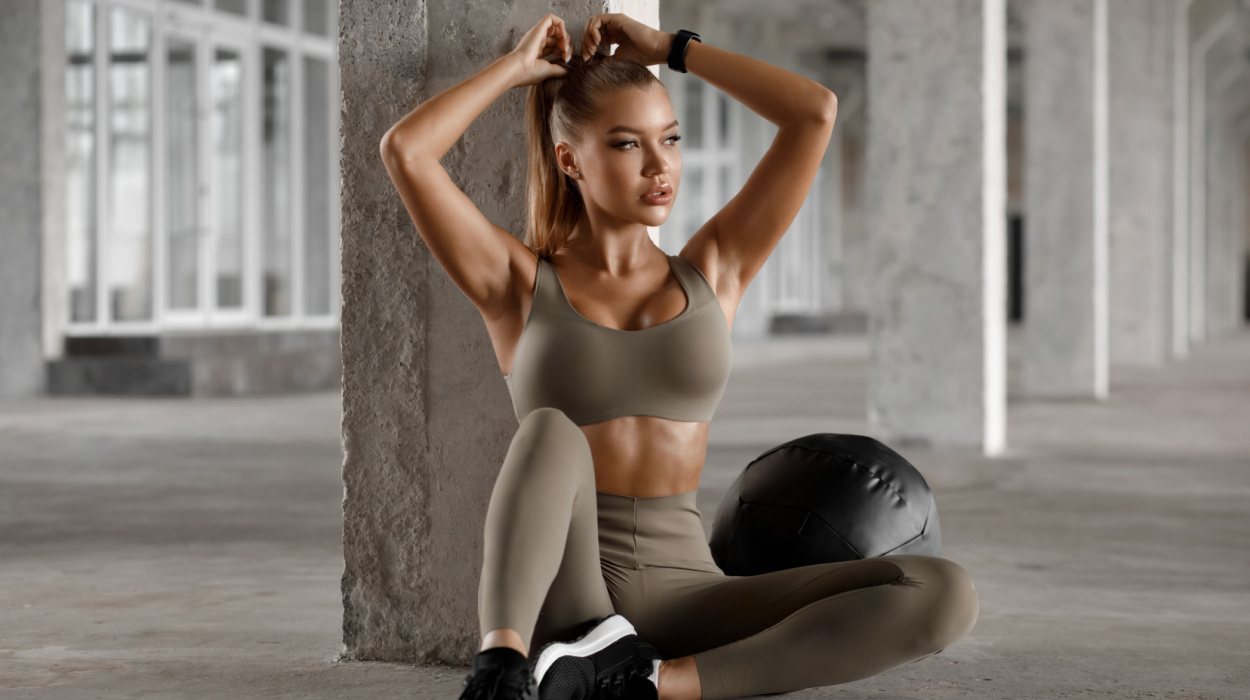Contrary to common misconceptions, building muscle is not about bulk but rather sculpting a strong, toned physique that complements a woman’s natural body shape. While losing fat has many health benefits, it’s essential to preserve muscle mass simultaneously.
Tailoring your fitness routine to align with your personal preferences and lifestyle ensures that the journey to building muscle and managing body fat is effective and enjoyable for you. In the article, we explore how to build muscle and lose fat for females while explaining the various benefits of body composition.
How To Build Muscle And Lose Fat For Females
Five ways for women to burn fat and build muscle:
- Start doing high-intensity interval training.
- Try strength training.
- Increase your protein intake.
- Avoid excess calorie restriction.
- Try intermittent fasting.
5 Ways For Women To Burn Fat And Build Muscle
There are multiple ways women can effectively lose body fat and gain muscle simultaneously. We’ve uncovered five ways to lose fat and gain muscle so you can lead a healthier, active lifestyle.
Start Doing High-Intensity Interval Workouts
High-intensity interval training (HIIT) is a great cardio exercise that can simultaneously help you
burn fat[1] at the same time. These workouts have gained popularity in recent years.
One of the many reasons is that they take less time than traditional gym workouts, but you still get the same results. This is an excellent option if fitting in exercise seems impossible with your day-to-day schedule.
High-intensity interval training involves repeated bouts of high-intensity exercises[2] with rest periods between each exercise. For example, do jumping jacks for 45 seconds followed by resting for 15 seconds, then repeat the cycle with a new exercise.
The versatility of these workouts can prevent you from getting bored and keep your motivation high. Studies have shown these workouts to be effective in reducing body fat percentage.
Try Strength Training

When it comes to gaining muscle, weight training may be one of the first things that comes to mind. Not only does strength training help you gain lean muscle mass, but it also can help boost your metabolism.[3] An increased metabolism helps you burn more calories, which can help you lose fat quicker. This is why adding strength training into your routine can be a great option for losing fat and maintaining muscle mass.
We often assume strength training involves using free weights or gym equipment, but it also includes your body weight. Resistance training is an umbrella term that encompasses strength training. Resistance exercise is anything that makes your muscles work against a force or weight, including your body.
Examples of body weight exercises include pull-ups, push-ups, and abdominal crunches. You can easily incorporate these exercises into your routine, as it doesn’t require purchasing a gym membership or traveling far to have a great workout.
Increase Your Protein Intake
Aside from exercise, it’s also essential to consider nutrition’s role, especially protein intake.
A balanced and adequate intake of dietary protein is essential for maintaining health and supporting various physiological processes inside your body.
When it comes to muscle growth, increasing protein intake has been associated with greater muscle gains[4] when combined with resistance training. It’s also been shown to help limit muscle loss naturally occurring as we age.
The Recommended Dietary Allowance for protein is 1.2 grams per kilogram daily for most adults. The International Society for Sports Nutrition recommends adults who need more protein and athletes should get 2.0 grams per kilogram daily.[4]
It’s important to note that this is the minimum requirement to meet your body’s requirements and prevent muscle mass loss. So, when it comes to building muscle, more protein is needed.
Foods that contain high protein include eggs, lentils, Greek yogurt, and lean meats like chicken. If you find it challenging to get in extra protein, you can always supplement with protein powder. Whey protein is a popular option when it comes to protein supplementation. One scoop of whey protein[5] can pack an impressive 20 grams of protein.
Avoid Excess Calorie Restriction
Regarding weight loss, you may think it’s best to restrict calories or be in a calorie deficit. While this is a practical approach for weight loss alone, it doesn’t account for building muscle. Too much of a restricted diet can lead to muscle loss and make it more difficult to build muscle,
A study found that adequate protein intake combined with physical activity can help you maintain muscle mass[4] and improve your muscle strength at the same time.
In this study, participants had a slightly lower calorie intake but avoided extreme restrictions. We recommend a healthy diet focusing on whole foods and limiting processed foods to avoid excess calorie consumption. By incorporating a balanced diet, you can help reduce body fat while still getting in all the necessary nutrients.
You can also experiment with supplements, such as certain fat burners for women. Fat burners are designed to promote weight loss by boosting your metabolism, which can help you burn more fat. However, it’s important to discuss with your primary healthcare provider before taking any supplements, especially if you’re currently taking any prescription medications.
Try Intermittent Fasting

Recently, intermittent fasting has gained popularity for its supposed fat-burning benefits. There are many different types of fasting, but we will focus on time-restricted feeding, one of the most common types of intermittent fasting. This involves only eating during a specific time window while fasting for 12 to 20 hours.[6]
One study found that limiting your eating time to six hours and fasting for 18 hours kickstarted a metabolic switch[7] from energy-using glucose to energy-using ketones. The body breaks down glucose when we eat and converts it into energy. But when we fast for prolonged periods, our bodies start to break down fat instead, which is why intermittent fasting is effective for weight loss.
Body Recomposition For Women
Body recomposition is the official term for building muscle and losing fat simultaneously. Research has shown that multiple factors, including diet and exercise routines, influence overall body composition for females. Research has shown that combining resistance training and cardio is an effective approach[8] to achieve this goal.
Additionally, multiple studies have shown diet influences body recomposition without incorporating an exercise routine. Quality of sleep and hormones also contribute to body recomposition, although the reason for this is not fully understood.
Because there are so many different approaches, it can be confusing to understand what the best option for muscle building is. Ultimately, it comes down to your lifestyle habits on how to lose fat and gain muscle simultaneously for females. Based on the studies above, we recommend eating a balanced diet that limits processed foods while incorporating an exercise program that combines strength and cardio.
The current activity recommendation for cardio is to get at least 150 minutes of moderate-intensity[9] aerobic exercise per week. Broken down, this is about 30 minutes daily, five times a week. Experts recommend that adults get at least two hours weekly of strength training.
Benefits Of Building Muscle And Losing Fat For Women
One of the top benefits of building muscle and losing fat is an improved quality of life. Being physically strong through strength training[3] has been shown to increase lean muscle mass, metabolic rate, and bone strength. Strong bones can help decrease your risk of energy and build back lost muscle tissue that commonly occurs as you get older.
An increased metabolic rate through strength training makes it easier to lose weight and can help you keep excess pounds at bay. Not only does losing weight improve many women’s body image and self-esteem but there are also many fantastic health benefits. Some of the big ones include decreased risk of type 2 diabetes, cancer, and depression.[10]
All of these factors can significantly impact one’s quality of life. By taking care of yourself now, you can live a more fulfilled life while looking out for your future self.
How Long Does It Take To See Results?
Building muscle and losing fat depends on many factors, such as age, genetics, and current lifestyle habits. These include physical activity, diet, and alcohol consumption. It also depends on individual fitness goals, as not everyone has the same desired outcome.
For body recomposition, more research is needed to determine the estimated length. But we can get a better idea when we look at muscle building and weight loss separately. For starters, increasing muscle mass is not a quick process. It takes consistency and patience.
Research has shown that you can typically see results after around eight weeks[11] of following a structured strength training routine. Weight loss can usually happen faster, but it’s important to remember the factors mentioned above that play into how quickly you lose weight. Additionally, experts recommend aiming to lose a maximum amount of 1-2 pounds per week,[12] as rapid weight loss has been shown to result in unfavorable outcomes. Incorporating a calorie deficit of 500-1,000 kcal daily can help you reach this goal.
Conclusion
There’s no quick fix when it comes to body recomposition. Consistency and determination are vital to seeing effective results, so patience is important. For physical activity, high-intensity interval and strength training are great ways to build muscle[2] and get in your daily cardio.
It’s also essential to consider your food intake, especially how much food you are eating and the quality of your food. We suggest a balanced diet focusing on whole foods and limiting processed, sugary snacks.
Rather than implementing a caloric restriction, focus on getting adequate protein consumption. Getting enough protein can help with muscle recovery and muscle growth. You can also try intermittent fasting to help burn fat and avoid excess calorie consumption.
It’s important to remember the other factors influencing how long it will take to see results, such as age, genetics, lifestyle habits, and your starting point. By remaining consistent, you’re more likely to see results that last for the long haul while being able to experience an improved quality of life.
Frequently Asked Questions
Focus on whole foods and limit processed foods. Additionally, increase your protein intake to help build muscle[5] and improve recovery.
It depends on your specific goals and current weight/ body fat percentage.
Studies have found exercise without a caloric restriction[13] to still have favorable results.
Multiple things can help you burn fat. For example, high-intensity interval training has been shown to be an effective form of cardio for burning fat.[1]
 Evidence Based
Evidence Based